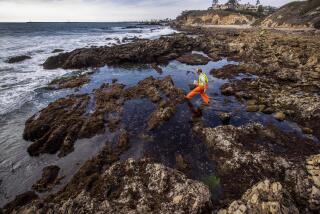Navy Rejects Safety Proposals in Sub Accident : Inquiry: NTSB chairman criticizes lack of action on recommendations made after 1989 fatal incident in which a tugboat was sunk off Long Beach.
- Share via
WASHINGTON — The U.S. Navy has rejected a trio of safety recommendations by the National Transportation Safety Board in the wake of a 1989 accident off the coast of California in which a submarine sunk a tugboat after snagging its towing cable, according to a letter released Tuesday by the NTSB.
In an April 29 letter to Chief of Naval Operations Frank B. Kelso II, safety board Chairman James L. Kolstad called it “regrettable” that the Navy refused to act on recommendations offered by the agency responsible for ensuring the safety of commercial transportation. The accident that prompted the recommendations involved the attack sub Houston and occurred off the coast of Long Beach.
The proposals were “made, not with the intent of compromising the Navy’s important and strategic mission, but rather to ensure the safe and legitimate use of U.S. coastal waters by all who sail upon them,” Kolstad wrote.
Kolstad’s missive came after the Navy dismissed as “closed-unacceptable action” the NTSB’S proposal that submarines operating in heavily traveled coastal waters use their active sonar to scan for surface vessels before rising to periscope depth.
The Navy, in a dispute over the findings in a September, 1990, accident report, also rejected two of the board’s other recommendations: that the service require longer rest periods for officers before they stand watches, and that the Navy change its procedure for notifying Coast Guard search and rescue authorities when a warship has had an accident with a civilian vessel.
A Navy spokesman said the Navy has not received the safety board’s letter. The Navy’s investigation of the June 14, 1989, incident found that the sub’s crew correctly identified the presence of the tugboat as it rose toward the surface, but did not and could not have known that it was attached by cable to a pair of barges.
Six months after the incident, the Navy relieved Cmdr. John H. Sohl, skipper of the Houston at the time of the accident, of his command, citing lack of confidence.
“There’s no disagreement between the Navy and NTSB with regard to the importance of safe operations,” said a Navy spokesman who asked not to be named. “That’s not at issue, since safety is paramount in Navy operations. The Navy’s differences are over technical aspects of recommendations made by NTSB, and they are the subject of discussions between the Navy and NTSB.”
One of the tug’s crew members died after the Houston ascended to periscope level in the heavily traveled waters between Santa Catalina Island and Long Beach. In its inquiry, the NTSB concluded that the Houston had failed to “effectively utilize its available sonar detection equipment” because it relied on passive sonar, which listens for engine and wake noises, to scan for vessels on the surface.
In its principal recommendation to the Navy, the NTSB proposed that except in cases where national security would be compromised, Navy subs operating in such areas be required to use their active sonar to search for possible surface traffic.
But the Navy concluded that the use of active sonar in shallow coastal waters, and against vessels such as barges with shallow drafts, would increase confusion for mariners, a Navy source told The Times. The “pinging” sound of active sonar would reverberate back and forth between several surfaces, including the vessel and the ocean’s bottom, and could reflect misleading signals to a sub’s commander, the source said.
More to Read
Sign up for Essential California
The most important California stories and recommendations in your inbox every morning.
You may occasionally receive promotional content from the Los Angeles Times.














